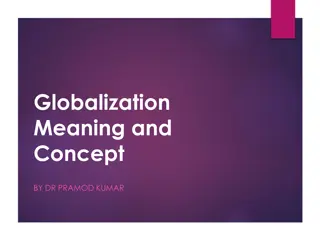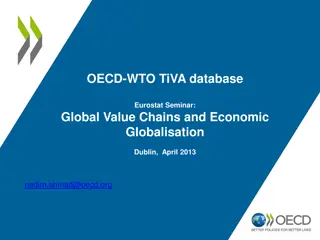Understanding International Trade and Globalization
Explore the concepts of international trade, globalization, and their impact on the global economy. Discover how trade dynamics have evolved over the years, the role of tariffs and quotas, and the implications of trade imbalances. Delve into the effects of globalization and the interdependence of economies worldwide. Gain insights into trade definitions, trends in U.S. trade, and the factors shaping global trade patterns.
Download Presentation

Please find below an Image/Link to download the presentation.
The content on the website is provided AS IS for your information and personal use only. It may not be sold, licensed, or shared on other websites without obtaining consent from the author. Download presentation by click this link. If you encounter any issues during the download, it is possible that the publisher has removed the file from their server.
E N D
Presentation Transcript
19 International Trade
Class Activity: Think-Pair-Share: Which Country Made Your T-Shirt? 1 Shoes Pants Shirts Country of Origin
Previously The healthcare debate is about efficiency and cost containment. Insurance changes the incentives that consumers and producers face when making healthcare decisions. Asymmetric information affects incentives in healthcare delivery. Inelastic demand, third-party payments, licensing requirements, and the market power of providers explain the high costs of health care.
Big Questions 1. Is globalization for real? 2. How does international trade help the economy? 3. What are the effects of tariffs and quotas?
Practice What You Know1 How would you characterize world trade in goods over the past 40 years? A. It has decreased dramatically. B. It has grown dramatically. C. It has decreased steadily. D. It has grown steadily.
Is Globalization for Real? What do we mean by globalization ? The increased interdependence of economies around the world Where is this made ? What has caused a modern trade explosion?
Some Trade Definitions Net exports Total exports of final goods and services minus total imports of final goods and services Trade balance Total exports minus total imports Trade surplus: exports > imports Trade deficit: imports > exports
Trends in U.S. Trade: Total Goods and Services
Trends in U.S. Trade: Goods Only
Trends in U.S. Trade: Services Only
Practice What You Know2 In the United States, imports and exports: A. are generally equal. B. have both risen in the last 50 years. C. are not greatly affected by recessions. D. don t play a large role in GDP.
Practice What You Know3 Which is true with regard to U.S. trade? A. The United States has run a trade deficit since 1975. B. U.S. exports > U.S. imports. C. The United States does most of its trading for oil from the Mideast. D. The United States only does a small amount of trading with Mexico and Canada.
Practice What You Know4 Which of the following claims is true? A. The United States has a trade deficit in both goods trade and service trade. B. The United States has a trade surplus in both goods trade and service trade. C. The United States has a trade deficit in goods trade, but a surplus in service trade. D. The United States has a trade surplus in goods trade, but a deficit in service trade.
Major Trading Partners of the United States 1 United States imports goods from 238 nations, but 60% of our imports come from just 10 nations. China Imports: $467 billion Exports: $124 billion
Major Trading Partners of the United States 2
Outsourcing in The Simpsons, Kiss Kiss, Bang Bangalore Homer goes to India to train and supervise factory workers. Tip #648: Outsourcing in The Simpsons, Kiss Kiss, Bang Bangalore
Outsourcing in John Stossel: Outsourcing John Stossel challenges conventional wisdom that outsourcing results in American jobs being lost. Tip #651: Outsourcing in John Stossel: Outsourcing
Outsourcing in Arent Sweatshops Exploitive? John Stossel explains the benefits of outsourcing, and how boycotts of sweatshops end up harming those workers the boycotts are intended to help. Tip #652: Outsourcing in Aren t Sweatshops Exploitive?
Does International Trade Help the Economy? How does comparative advantage and specialization make it possible to achieve gains from trade between nations? Comparative advantage: The ability to produce a good at a lower opportunity cost than a competitor can.
Gains from Trade1 United States and Mexico produce food and clothing. Food is capital intensive, and clothing is labor intensive. United States has abundant capital, and a skilled workforce. Mexico has a less-skilled workforce. Which country will specialize in which good?
Production Possibilities Without Specialization and Trade
Gains from Trade2 Which country should specialize in which good? Mexico should specialize in clothing production. The United States should specialize in food production.
Gains from Trade3 How much will one unit of clothing trade for? Mexico will want more than 1/3 unit of food for one unit of clothing. The United States will want to give less than 2 units of food for one unit of clothing. 1/3 food < Price of one unit clothing < 2 food
Production Possibilities With Specialization, Trade
Economics in I, Pencil Leonard E. Read (I, Pencil) Illustrates that trade is necessary even to produce a simple good: the pencil Tip #658: Why We Trade in I, Pencil
Practice What You Know5 Gains from trade come from: A. different exchange rates and currency manipulation across borders. B. larger countries taking advantage of smaller countries that must import most goods. C. countries producing goods in which they have a comparative advantage. D. wealthy countries freely giving goods and services to developing countries.
Class Activity: ThinkPairShare1 Output and Opportunity Cost for Canada and the United States Chosen Output Level Food Cars Opportunity Cost Food Cars Canada 100 20 United States 500 50 1. Calculate the opportunity costs of food and cars for each country. 2. Which country should specialize in food? In cars? 3. If Canada and the United States trade, how much food will a car trade for (there are multiple answers).
Class Activity: ThinkPairShare2 Output and Opportunity Cost for Canada and the United States Chosen Output Level Food Cars Opportunity Cost Food Cars Canada 100 20 1/5 Car 5 Food United States 500 50 1/10 Car 10 Food 1. Calculate the opportunity costs of food and cars for each country. 2. Which country should specialize in food? In cars? 3. If Canada and the U.S. trade, how much food will a car trade for (there are multiple answers).
Other Advantages of Trade1 Economies of scale Specialization can lead to lower production costs. Smaller countries get access to goods that require large-scale production. Increased competition Forces domestic firms to be more innovative and efficient. Consumers have more choice.
Other Advantages of Trade2 Trade Agreements NAFTA: North American Free Trade Agreement Signed in 1992 Eliminated nearly all trade restrictions between Canada, the United States, and Mexico WTO: World Trade Organization Facilitates trade agreements among nations Resolves disputes
Trade and Institutions Institutions and laws also affect trade. This is another positive aspect of trade; it gives an incentive to create good institutions within a country. Stable institutions and laws Products must meet standards of other countries. Nations with stable currency and less corruption are more desirable trading partners. Firms also want to trade where law is followed.
Reality of Trade Benefits may be larger than expected. Economies of scale may create nonlinear PPFs, lowering costs with increased production. Benefits may not be as large. Transportation is not costless, and may reduce gains from trade from countries that are geographically separated. Governments may enter markets and impose tariffs and quotas on imports to protect domestic producers.
What Are the Effects of Tariffs and Quotas? 1 Protectionism Government policies that restrict or restrain international trade. Why would the government want to restrict trade? To protect domestic industries and jobs from foreign competition.
What Are the Effects of Tariffs and Quotas? 2 Tariff Taxes levied on imported goods and services. Ad valorem tax vs. specific tax. Import Quotas Limits on the quantity of products that can be imported into a country. Japan and voluntary export restraints on cars. Who gains? Who loses?
What Are the Effects of Tariffs and Quotas? 3 Tariff recap: Consumers lose since they pay more and buy less. Domestic producers gain since they can now sell more. Foreign producers lose since the amount they sell falls. There is a welfare loss since total sales are down, and inefficient producers increase production.
What Are the Effects of Tariffs and Quotas? 4 Is there a loss not seen in the graph on slide 38? Fewer sales by U.S. exporters.
What Are the Effects of Tariffs and Quotas? 5 Quota recap: Similar to a tariff, except with a quota there is no government tariff revenue. Foreign producers will voluntarily agree to restrict their exports.
What Are the Effects of Tariffs and Quotas? 6 Is there another loss from protection? Goods that could have been produced using the resources reallocated to the protected industry.
Reasons Given for Trade Barriers 1 National security Better to produce goods vital to national defense on your own. Infant industry argument New domestic industries need trade protection until they can compete internationally. Two possible problems
Reasons Given for Trade Barriers 2 Retaliation for dumping Dumping is the sale of a good by a foreign supplier at a price below what it is sold for in their home country. Used to penetrate a foreign market. If dumping subsidized, countries can impose countervailing duties to offset. Favors to special interests
Practice What You Know6 One result of a tariff on imported goods is: A. increased trade of the good. B. increased economic efficiency. C. lower prices for the imported good. D. deadweight loss.
Practice What You Know7 Why is dumping often seen as unfair? A. People don t like imports. B. Consumers don t like when the prices fall too low. C. It is often the result of foreign government subsidies rather than legitimate comparative advantage. D. It allows domestic and foreign firms to collude and raise prices of goods.
Conclusion U.S. imports and exports are higher than previous generations. Trade creates value when countries specialize in producing goods in which they have a comparative advantage. Tariffs and quotas lead to higher prices, more domestic production, less domestic consumption, and a welfare loss. Barriers to trade exist for various political and economic reasons, but barriers are eroding worldwide.
Class Activity: Think-Pair-Share: Which Country Made Your T-Shirt? 2 Shoes Pants Shirts Bangladesh China India Malaysia Thailand























